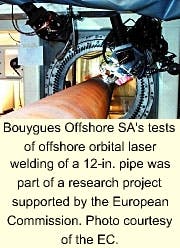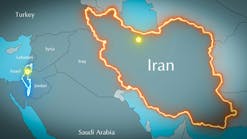Bouygues Offshore SA is developing its own scheme for use in J and S offshore pipelay based on high-powered, laser-beam welding (LBW) technology.
Use of carbon dioxide LBW in order to execute high-speed welds in applications with small thicknesses is relatively commonplace, says Bouygues Offshore.
Also available, however, are compact CO2 lasers of up to 20 kw that allow welds in applications with higher wall thicknesses while realizing the same benefits of using LBW-namely, high rate of production and full automation.
Bouygues Offshore's technology development scheme entails a focus on process and metallurgical weldability, welding equipment development and construction, and integration in a lay barge and offshore welding tests. Pipes involved are 6-34 in. OD and as much as 15 mm W.T.
Commissioned and tested off Pointe Noire, Congo, in 1997, the equipment was integrated on a lay barge, where 100 such welds were executed, reported the European Commission's Oil & Gas Technology newsletter.
During this test, no difficulties linked to barge motion were experienced in the laser generator, welding machine, or process behavior, test organizers said.
Test results
Bouygues Offshore demonstrated its technique's metallurgical weldability on a variety of steel grades during a recent EC-supported project.
Results from this test showed that:
- The LBW process can produce acceptable orbital single-run welds in line-pipe steel measuring 10-15 mm W.T.
- Welding associated with sensors to expand the acceptable tolerance can be operated in a fully automated welding cycle on industrial line pipe.
- The system can be operated in difficult environments-on an offshore lay barge, for example-and can be used reliably for all-position 5G welding experienced in S-lay operation.
- Welded joints' compliance with the standard pipeline construction requirements is achieved on industrial line pipe, given that the quality and type of line pipe are consistent with the application.
LBW may be an alternative for future deepwater, J-lay pipelines, said the company. The horizontal 2G position of the joint is easier for the performance of heavy wall-thickness, single-run welds, and the unique working station may allow the LBW to realize maximum efficiency.



